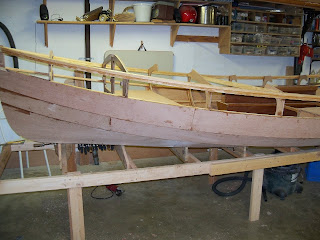Work has slowed a bit as we move into the rainy season here in the Pacific Northwest. Not only are the days getting shorter, colder and wetter, but I'm back to working overtime. *sigh*
Nevertheless, I'm glad to say that I am making some progress.
I've got most of the third row of planking on.
I've fitted the anchor well floor, the front seat, and started fitting the rear side seats. It's a good idea to cut these to size before installing the third row of planking. It's much easier to fit them in place over sized and scribe the outer hull position using a batten then to try and fit them later.
I have learned two valuable lessons this time around:
Lesson #1. Carefully inspect your plywood, no matter how good it's supposed to be. After installing part of my starboard plank, I noticed that something looked odd at one of the edges. Closer inspection revealed this:
.
Yikes! About a half inch of the edge of this sheet of plywood didn't get bonded properly. I'm using Aquatek BS-6566 marine plywood and I've built two boats using this stuff, and this is the first time I've run across a flaw like this. I had to trim a half inch from the forward edge of one of my planks, which was already installed, to get rid of the bad edge. I'm inspecting every piece from now on.
Lesson#2: When installing the planks, it's easy to clamp them along the top edge, but the bottom edge has to be fastened with screws, which are removed after the epoxy cures. This leaves a line of ugly screw holes that has to be plugged and sanded. I started doing it this way but then I found a better way. Now I use my PowerShot staple & nail gun loaded with 1/2" nails.
This stapler has just enough power to drive these tiny little nails most of the way through a 1/4" sheet of plywood and into the underlying stringer. To install the plank, I goop the stringers up with "peanut butter", clamp the plank in place along the top, then press firmly along the bottom and drive in a nail every few inches or so.
The little nails are easily pulled later on with a pair of pliers, leaving just a little pinhole. The only downside is that the stapler has a tendency to jam but it still beats using screws by a long shot IMHO.
This blog is devoted to my John Welsford designed 15' Navigator yawl Ellie. I built her in my garage over a period of 18 months and launched her in 2011. She sports a sliding gunter main, roller furled jib and sprit-boomed mizzen. Her construction is glued-lapstrake over permanent bulkheads and stringers. This blog is a record of her construction and her voyages here in the Puget Sound area and (hopefully) a useful resource for fellow Welsford boat builders.
TABLE OF CONTENTS
- Full Size Paper Patterns
- CNC files
- DIY Roller Furler
- DIY Jam Cleats
- DIY Boom Tent
- DIY Wooden Blocks
- DIY Folding Step Ladder
- DIY Tiller Lock
- DIY Wood & Leather Scoop Bailer
- Puzzle Joint Router Jig
- 3D Print Hardware
- Dinghy Cruising Packing List
- Is a Tabernacle Necessary?
- Laid Decking part 1
- Laid Decking part 2
- Nearshore Anchoring Methods
- Re-Boarding Straps
- Really Simple Sails
- Rigging my Sliding Gunter Yawl
- Self-Steering Yawls
- Setup Time
- ShopSmith Boatbuilding
- Sleeping Aboard
- Suzuki vs Honda 2hp Outboards
- Daysail Videos
- Build History






